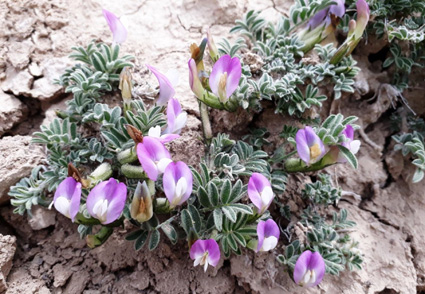Abstract
An emended description of Iranian endemic Astragalus durandianus is provided with illustrations and extra information on several morphological characters not indicated in the protologue, including corolla characteristics, the habit size, peduncle length, bigger fruit size, black hairs on the fruits and several other differences. Based on field observations, a brief description of the habitat and data on ecology and biogeography of the species are provided. The conservation status of all species of Astragalus section Trachycercis in the Iranian plateau is evaluated.
References
Azani, N., Bruneau, A., Wojciechowski, M.F. & Zarre, S. (2017) Molecular phylogenetics of annual Astragalus (Fabaceae) and its systematic implications. Botanical Journal of Linnean Society 184: 347–365. https://doi.org/10.1093/botlinnean/box032
Azani, N., Bruneau, A., Wojciechowski, M.F. & Zarre, S. (2019) Miocene climate change as a driving force for multiple origins of annual species in Astragalus (Fabaceae, Papilionoideae) Molecular Phylogenetics and Evolution 137: 210–221. https://doi.org/10.1016/j.ympev.2019.05.008
Bachman, S., Moat, J., Hill, A.W., de la Torre, J. & Scott, B. (2011) Supporting Red List threat assessment with GeoCAT: geospatial conservation assessment tool. ZooKeys 150: 117–126. https://doi.org/10.3897/zookeys.150.2109
Bagheri, A., Maassoumi, A.A. & Ghahremaninejad, F. (2011) Description of Astragalus barnasariformis sp. nov. from Iran. Rostaniha 12(2): 177–180.
Bornmüller, J. (1914) Reliquiae Straussianae. Weitere Beiträge zur Kenntnis der Flora des west-lichen Persiens. Beihefte zum Botanischen Centralblatt. Abt. 2. 32(2): 349–419.
Bunge, A.A. (1868) Generis Astragali Species Gerontogeae. Mémoires L’Académie Impériale des Sciences de Saint Pétersbourg Série 7. 11 (16): 1–140.
Ghahremaninejad, F. (2004a) The sections of Astragalus with bifurcating hair in Iran. Turkish Journal of Botany 28 (1/2): 101–117.
Ghahremaninejad, F. (2004b) Value of trichome characteristics for separating of bifurcating Astragalus (Fabaceae) on sectional level. Turkish Journal of Botany 28(1/2): 241–245.
Ghahremaninejad, F., Joharchi, M.R., Memariani, F. & Behroozian, M. (2022) Astragalus nigriceps Popov (Fabaceae): conservation, geography, endemism, systematics. Phytotaxa 536 (3): 243–251.
Ghahremaninejad, F., Nejad Falatoury, A. & Memariani, F. (2020) Typification and an emended description of Astragalus moussavii (Fabaceae, Papilionoideae). Phytotaxa 441 (1): 60–68. https://doi.org/10.11646/phytotaxa.441.1.5
Grossheim, A.A. (1940) Izvestiya Azerbaidzhanskogo Filiala, vol. 1. Akademii Nauk SSSR, Baku.
Hijmans, R.J., Guarino, L., Cruz, M. & Rojas, E. (2001) Computer tools for spatial analysis of plant genetic resources data: 1. DIVA-GIS. Plant Genetic Resources Newsletter 127: 15–19.
IUCN (2019) Guidelines for Using the IUCN Red List Categories and Criteria. Version 14. Prepared by the Standards and Petitions Subcommittee. Downloadable from: http://www.iucnredlist.org/documents/RedListGuidelines.pdf (accessed 10 July 2021)
Maassoumi, A.A. (2005) The genus Astragalus in Iran. Vol. 5. Research Institute of Forests and Rangelands of Iran, Tehran.
Maassoumi, A.A. (2018) Papilionaceae (Astragalus III). In: Assadi, M. & Maassoumi, A.A. (Eds.) Flora of Iran, No. 145. Research Institute of Forests and Rangelands of Iran, Tehran, 766 pp.
Maassoumi, A.A., Safavi, S.R., Alizadeh, B., Joharchi, M.R. & Amirabadizadeh, H. (2005) Some new records of the genus Astragalus in Iran. Iranian Journal of Botany 11(1): 111–113.
Memariani, F., Zarrinpour, V. & Akhani, H. (2016) A review of plant diversity, vegetation, and phytogeography of the Khorassan-Kopet Dagh floristic province in the Irano-Turanian region (northeastern Iran– southern Turkmenistan). Phytotaxa 249: 8–30. https://doi.org/10.11646/phytotaxa.249.1.4
Memariani, F. (2020) The Khorassan-Kopet Dagh Mountains. In: Noroozi, J. (Ed.) Plant Biogeography and Vegetation of High Mountains of Central and South-West Asia. Springer Nature Switzerland AG, Cham, pp. 93–116. https://doi.org/10.1007/978-3-030-45212-4_3
Pallas, P.S. (1800) Species Astragalorum: descriptae et iconibus coloratis illustratae. Leipzig, 92 pp., 84 tab. https://doi.org/10.5962/bhl.title.46625
Podlech, D. (1973) Neue und bemerkenswerte Astragalus-Arten aus Afghanistan (Beiträge zur Flora von Afghanistan VI). Mitteilungen der Botanischen Staatssammlung München 11: 259–321.
Podlech, D. (2004) New species of Astragalus L. (Leguminosae), mainly from Iran. Annalen des Naturhistorischen Museums in Wien 105B: 565–596.
Podlech, D. & Zarre, S. (2013) A taxonomic revision of the genus Astragalus L. (Leguminosae) in the Old World. Naturhistorisches Museum, Wien, 2439 pp.
Podlech, D., Zarre, S., Maassoumi, A.A., Ekici, M. & Sytin, A. (2010) Papilionaceae VI, Astragalus IV. In: Rechinger K.H. (Ed.) Flora Iranica, Lfg. 178. Naturhistorisches Museum, Wien, 430 pp.
Ranjbar, M. (2009) Astragalus sect. Trachycercis (Fabaceae) in Iran. Nordic Journal of Botany 27: 328–335. https://doi.org/10.1111/j.1756-1051.2009.00187.x
Thiers, B. (2021 [Continuously updated]) Index Herbariorum: A global directory of public herbaria and associated staff. New York Botanical Garden’s Virtual Herbarium. Available from: http://sweetgum.nybg.org/ih/ (accessed 10 July 2021)
Zarre, S. (2003) Hair micromorphology and its phylogenetic application in thorny species of Astragalus (Fabaceae). Botanical Journal of the Linnean Society 143: 323–330. https://doi.org/10.1046/j.1095-8339.2003.00220.x


